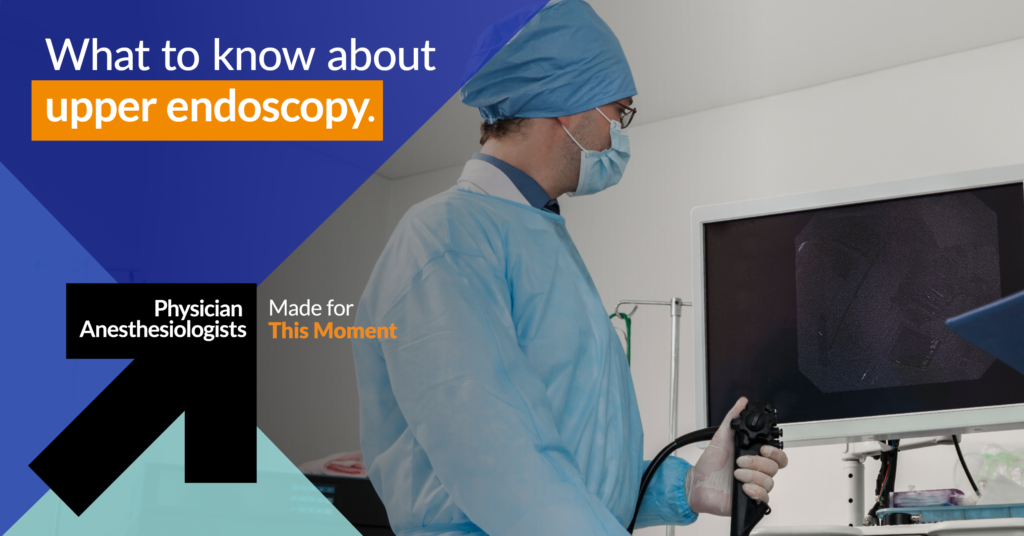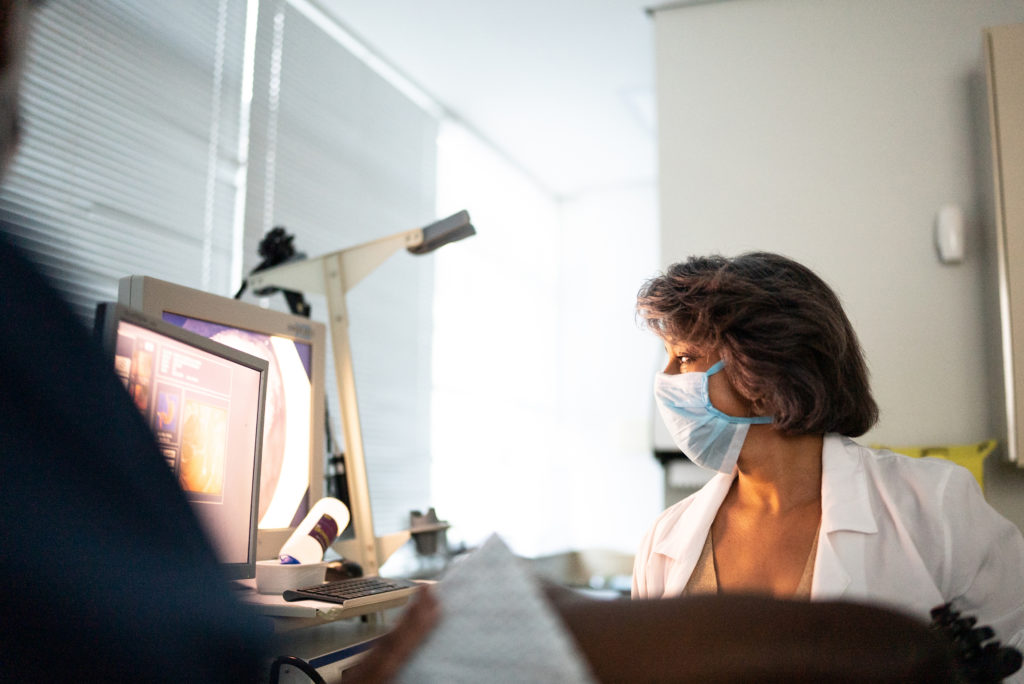Upper Endoscopy
Endoscopy is a medical procedure in which a doctor looks inside your body using an instrument called an endoscope—a long, thin, flexible tube with a tiny camera attached to it. Endoscopy is used for many examinations, but an upper endoscopy is used specifically to look at the esophagus, the stomach, and the first part of the small intestine (called the duodenum). An estimated 6.1 million upper endoscopies are performed in the U.S. each year1.
You may also hear the procedure called an upper GI endoscopy, esophagogastroduodenoscopy, or EGD. Whichever term is used, it’s important to understand the preparation, anesthesia, and post-procedure recovery involved, as well as the anesthesiologist’s role in keeping you safe and comfortable.

What diseases can an upper endoscopy detect?
An upper endoscopy can help identify gastroesophageal reflux disease (GERD), ulcers, cancer, precancerous abnormalities, and celiac disease, among other conditions.
When is an upper endoscopy needed?
Often, the impetus for the examination is to assess the cause of symptoms, such as persistent heartburn or acid reflux, bleeding (or dark stools that can indicate bleeding), nausea and vomiting, stomach pain, difficulty swallowing or pain while swallowing, and unexplained weight loss. People with cirrhosis may undergo upper endoscopies on a regular basis because of the disease’s potential to cause life-threatening enlargement or swelling of veins on the esophageal lining.
How should I prepare for an upper endoscopy?
You should not eat or drink anything for at least 8 hours before the procedure. Your doctor may advise you to begin your fast at midnight regardless of the time your endoscopy is scheduled to begin. Your doctor should also give you detailed instructions about what you can and cannot eat the day or two before your endoscopy. For example, you may be told to consume only clear liquids for 24 or 48 hours. You should follow all preparation instructions carefully to make sure the doctor will have a clear view of your upper gastrointestinal tract.
Be sure to provide your physician with a full list of all medications, vitamins, or other supplements you take. Your physician can then provide you with instructions about any you should temporarily stop taking to avoid complications such as bleeding.
What happens during an upper endoscopy?
Before the procedure begins, an IV will be inserted in your arm to administer anesthesia, and a bite block or plastic mouth guard will be placed in your mouth to protect your teeth, mouth, and the endoscope. You will most likely be positioned on your left side—before anesthesia is administered if undergoing sedation, but after if receiving general anesthesia. Once you have been anesthetized, your physician will insert the endoscope into your mouth and down your throat to conduct the exam. If you are under general anesthesia or moderate or deep sedation, you will not be aware of or remember what occurs during the procedure.

What are the considerations for anesthesia during the procedure?
Your endoscopy preparation should include an evaluation from an anesthesiologist, a medical doctor who specializes in anesthesia, pain management, and critical care medicine, who will asses your risk for anesthesia-related complications. They will ask about any medical conditions you have, because some conditions can impact the type and level of anesthesia that should be used.
Most types of anesthesia are administered through a vein in your arm. Options range from no anesthesia or sedation at all to general anesthesia, but for upper endoscopies, moderate or deep sedation is most common. The anesthetics that may be used to minimize pain and discomfort and reduce anxiety include propofol, benzodiazepines, and opioids.
- No sedation. Although it does not occur frequently, endoscopies can be performed with no sedation. This is sometimes necessary for extremely high-risk patients and some pregnant patients. A topical anesthetic is typically applied to the back of the throat to make it easier for you to tolerate the endoscope.
- Monitored sedation. The level of sedation can be minimal (you’ll feel drowsy but able to talk and follow directions), moderate (you may fall asleep), or deep (you will fall asleep). Under moderate or deep sedation, you’re likely to have no memory of the procedure, but you will not be unconscious.
- General anesthesia. Although rare for an upper endoscopy, general anesthesia may be used in hospital settings with high-risk patients. Under general anesthesia, you will be unconscious, and many of your body’s functions will slow down or need help to work effectively. A tube may be placed in your throat to help you breathe.
How long does an upper endoscopy take?
The procedure itself is very brief—typically 5 to 10 minutes—although it can be a bit longer if tissue is taken for biopsy.
What should I expect in recovery?
Your throat might feel sore from the insertion of the endoscope, and you might temporarily feel bloated because of the carbon dioxide or air that’s used to give the physician a better view of the stomach. Nausea is possible, but the propofol often used for anesthesia helps prevent it.
You’ll feel groggy for about 30 minutes after the procedure, but that feeling should start to fade within the hour. Even so, you should not make any big decisions the rest of the day, and you will need to have someone take you home.
What are upper endoscopy risks?
The risk of complications is low, as noted by the National Institute of Diabetes and Digestive and Kidney Diseases. It identifies low but potential risks as an abnormal reaction to the sedative, perforation in the lining of your upper GI tract, and bleeding from the site where the physician took tissue samples or removed a polyp, if necessary.
As with any procedure requiring anesthesia, factors such as obesity, respiratory disease, and sleep apnea can increase risk. But these risks can be managed, which is why consultation with an anesthesiologist is so important.
